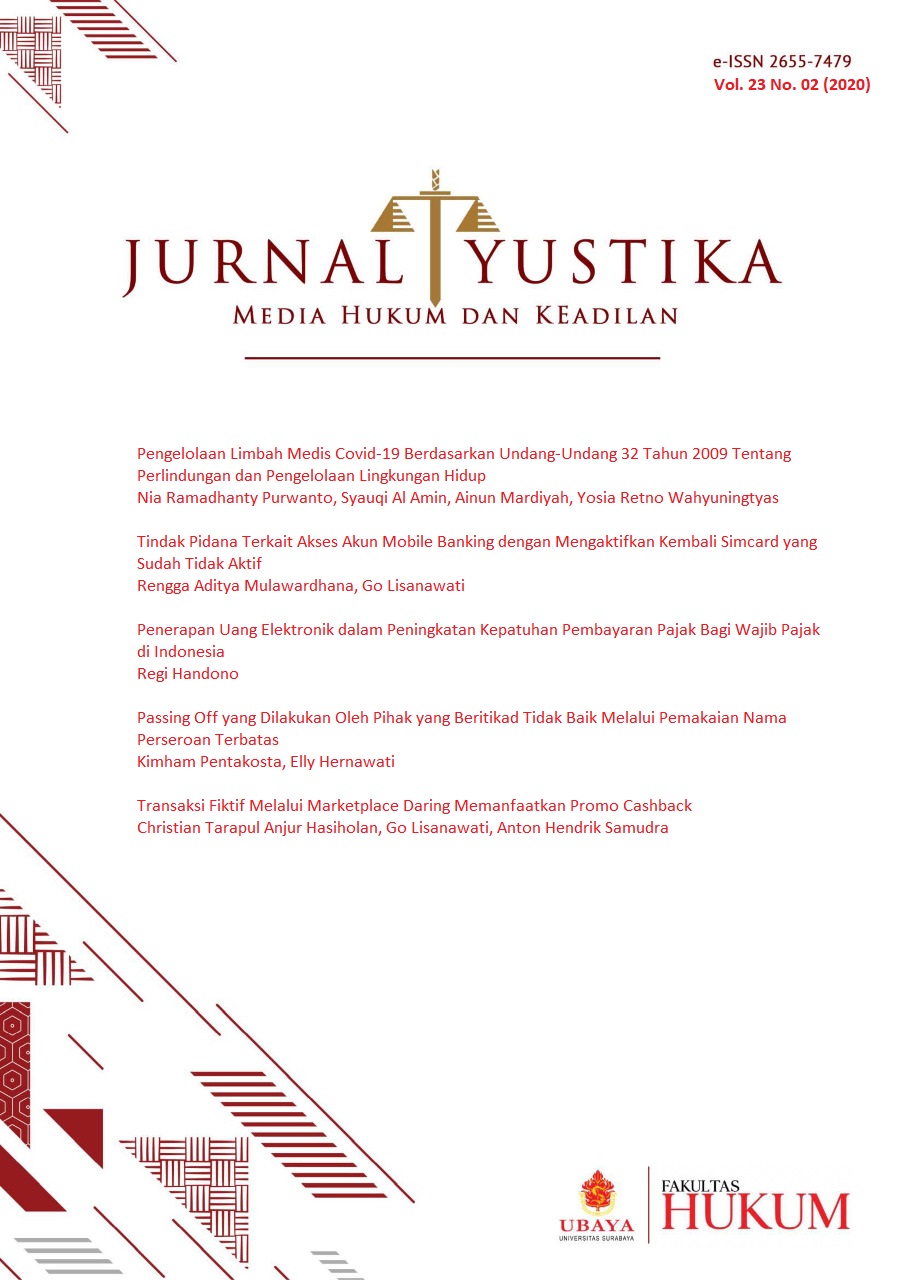Pengelolaan Limbah Medis Covid-19 Berdasarkan Undang-Undang 32 Tahun 2009 Tentang Perlindungan dan Pengelolaan Lingkungan Hidup
 Abstract Views:
3832 times
Abstract Views:
3832 times
 PDF Downloads:
5604 times
PDF Downloads:
5604 times
Abstract
Indonesia is currently undergoing major changes caused by Covid-19. One of the big changes is the increase in medical waste. Article 1 number 1 of Government Regulation No. 101 of 2014 concerning Waste Management of Hazardous and Toxic Materials ("PP No. 101 Of 2014") Covid waste is included in hazardous and toxic materials or B3 because it can harm health even to human safety. In addition to damaging the environment of medical waste used to handle Covid is at great risk of transmitting coronavirus if not managed appropriately. Because of this, this paper aims to control the presence of B3 waste so as not to further spread the virus and damage the environment. The method used is literature studies. The objective can be obtained by managing medical waste by means of reduction, storage, collection, transportation, management, hoarding. Every party that produces B3 waste must manage their waste that is infectious with Covid-19. It is not recommended to be immediately disposed of and can be destroyed first by burning and placed in a special place of infectious waste. It must be done the right management by separating the according with the type of waste. For the parties who still violate existing regulations, can be sanctioned. So that the environment can be protected and break the chain of spread of Covid-19.
Downloads
References
Angga, L. O. (2014). Penerapan Prinsip Kehati-hatian dalam Kebijakan Perlindungan dan Pengelolaan Lingkungan Hidup di Bidang Pertanian Untuk Keunggulan Varietas Produk Rekayasa Genetik. SUPREMASI HUKUM, Vol 3(Vol. 3).
BBC. (2020). Virus corona: Limbah infeksius Covid-19 masih ditemukan di TPA, “ada kelonggaran, pengabaian, dan tidak ada pengawasan.” BBC News. https://www.bbc.com/indonesia/majalah-54640725
CSSEGISandData. (2020). COVID-19 Data Repository by the Center for Systems Science and Engineering (CSSE) at Johns Hopkins University. Github.Com. https://github.com/CSSEGISandData/COVID-19
Farrington, I., Griekspoor, A., & Gurung, S. (2020). Mempertahankan layanan kesehatan esensial: panduan operasional untuk konteks COVID-19.
Fernan Rahadi. (2020). Penanganan Limbah Medis Saat Pandemi. Republika.Id. https://republika.co.id/berita/qjxi8w291/penanganan-limbah-medis-saat-pandemi
Hesti, Y. (2020). Upaya Penanganan Limbah B3 Dan Sampah Rumah Tangga Dalam Mengatasi Pandemi Corona. Jurnal Pro Justitia, 60–67.
Pertiwi, V., Joko, T., & Dangiran, H. L. (2017). EVALUASI PENGELOLAAN LIMBAH BAHAN BERBAHAYA DAN BERACUN (B3) DI RUMAH SAKIT ROEMANI MUHAMMADIYAH SEMARANG. JURNAL KESEHATAN MASYARAKAT (e-Journal), Volume 5(Nomor 3), 420–430. http://ejournal-s1.undip.ac.id/index.php/jkm
Prihartanto. (2020). PERKIRAAN TIMBULAN LIMBAH MEDIS BAHAN BERBAHAYA DAN BERACUN (B3) DARI RUMAH SAKIT PENANGANAN PASIEN COVID-19. Jurnal Sains Dan Teknologi Mitigasi Bencana, Vol. 15(No.1), 12–18. http://ejurnal.bppt.go.id/index.php/JSTMB/article/download/4118/pdf/12368
Rahmadi, T. (2016). Hukum Lingkungan di Indonesia. Rajawali Pers.
Sari, H. P. (2020). Varian Baru Virus Corona Bisa Dideteksi Lewat PCR. Kompas.Com. https://nasional.kompas.com/read/2020/12/29/11590451/idi-varian-baru-virus-corona-bisa-dideteksi-lewat-pcr
Sitepu, N. A. (2020). Upaya Memutus Rantai Infeksi Pada Limbah Padat Medis B3 (Bahan Berbahaya dan Beracun) di Rumah Sakit.
PP No.101 Tahun 2014 Tentang Pengelolaan Limbah Bahan Berbahaya Dan Beracun.
Surat Edaran Menteri Lingkungan Hidup No.SE.2/MENLHK/PSLB3/PLB.3/3/2020 tentang pengelolaan Limbah Infeksius (Limbah B3) Dan Sampah Rumah Tangga Dari Penanganan Corona Virus Disease (COVID-19).
UU No.32 Tahun 2009 Tentang Perlindungan Dan Pengelolaan Lingkungan Hidup.
Wikanto, A. (2020). Catat, inilah daerah zona merah corona di Jakarta per 17 Desember 2020. Kesehatan.Kontan.Co.Id. https://kesehatan.kontan.co.id/news/catat-inilah-daerah-zona-merah-corona-di-jakarta-per-17-desember-2020?page=all

This work is licensed under a Creative Commons Attribution-ShareAlike 4.0 International License.
All articles published in YUSTIKA are licensed under a Creative Commons Attribution-ShareAlike 4.0 International (CC BY-SA) license. This means anyone is free to copy, transform, or redistribute articles for any lawful purpose in any medium, provided they give appropriate attribution to the original author(s) and YUSTIKA, link to the license, indicate if changes were made, and redistribute any derivative work under the same license.
Copyright on articles is retained by the respective author(s), without restrictions. A non-exclusive license is granted to YUSTIKA to publish the article and identify itself as its original publisher, along with the commercial right to include the article in a hardcopy issue for sale to libraries and individuals.
Although the conditions of the CC BY-SA license don't apply to authors (as the copyright holder of your article, you have no restrictions on your rights), by submitting to YUSTIKA, authors recognize the rights of readers, and must grant any third party the right to use their article to the extent provided by the license.

 DOI:
DOI:




.jpg)




